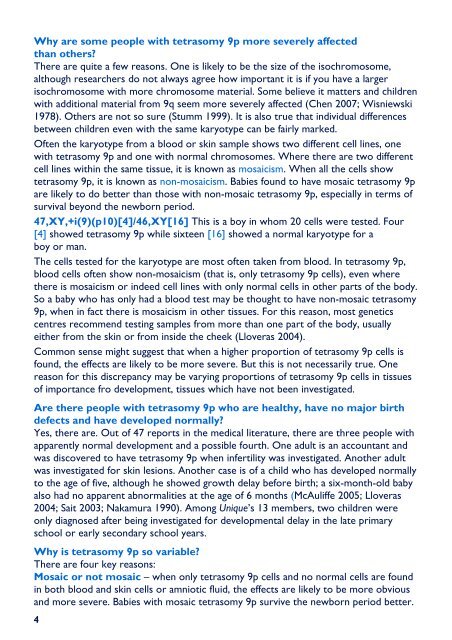Tetrasomy 9p FTNW - Unique - The Rare Chromosome Disorder ...
Tetrasomy 9p FTNW - Unique - The Rare Chromosome Disorder ...
Tetrasomy 9p FTNW - Unique - The Rare Chromosome Disorder ...
You also want an ePaper? Increase the reach of your titles
YUMPU automatically turns print PDFs into web optimized ePapers that Google loves.
Why are some people with tetrasomy <strong>9p</strong> more severely affected<br />
than others?<br />
<strong>The</strong>re are quite a few reasons. One is likely to be the size of the isochromosome,<br />
although researchers do not always agree how important it is if you have a larger<br />
isochromosome with more chromosome material. Some believe it matters and children<br />
with additional material from 9q seem more severely affected (Chen 2007; Wisniewski<br />
1978). Others are not so sure (Stumm 1999). It is also true that individual differences<br />
between children even with the same karyotype can be fairly marked.<br />
Often the karyotype from a blood or skin sample shows two different cell lines, one<br />
with tetrasomy <strong>9p</strong> and one with normal chromosomes. Where there are two different<br />
cell lines within the same tissue, it is known as mosaicism. When all the cells show<br />
tetrasomy <strong>9p</strong>, it is known as non-mosaicism. Babies found to have mosaic tetrasomy <strong>9p</strong><br />
are likely to do better than those with non-mosaic tetrasomy <strong>9p</strong>, especially in terms of<br />
survival beyond the newborn period.<br />
47,XY,+i(9)(p10)[4]/46,XY[16] This is a boy in whom 20 cells were tested. Four<br />
[4] showed tetrasomy <strong>9p</strong> while sixteen [16] showed a normal karyotype for a<br />
boy or man.<br />
<strong>The</strong> cells tested for the karyotype are most often taken from blood. In tetrasomy <strong>9p</strong>,<br />
blood cells often show non-mosaicism (that is, only tetrasomy <strong>9p</strong> cells), even where<br />
there is mosaicism or indeed cell lines with only normal cells in other parts of the body.<br />
So a baby who has only had a blood test may be thought to have non-mosaic tetrasomy<br />
<strong>9p</strong>, when in fact there is mosaicism in other tissues. For this reason, most genetics<br />
centres recommend testing samples from more than one part of the body, usually<br />
either from the skin or from inside the cheek (Lloveras 2004).<br />
Common sense might suggest that when a higher proportion of tetrasomy <strong>9p</strong> cells is<br />
found, the effects are likely to be more severe. But this is not necessarily true. One<br />
reason for this discrepancy may be varying proportions of tetrasomy <strong>9p</strong> cells in tissues<br />
of importance fro development, tissues which have not been investigated.<br />
Are there people with tetrasomy <strong>9p</strong> who are healthy, have no major birth<br />
defects and have developed normally?<br />
Yes, there are. Out of 47 reports in the medical literature, there are three people with<br />
apparently normal development and a possible fourth. One adult is an accountant and<br />
was discovered to have tetrasomy <strong>9p</strong> when infertility was investigated. Another adult<br />
was investigated for skin lesions. Another case is of a child who has developed normally<br />
to the age of five, although he showed growth delay before birth; a six-month-old baby<br />
also had no apparent abnormalities at the age of 6 months (McAuliffe 2005; Lloveras<br />
2004; Sait 2003; Nakamura 1990). Among <strong>Unique</strong>’s 13 members, two children were<br />
only diagnosed after being investigated for developmental delay in the late primary<br />
school or early secondary school years.<br />
Why is tetrasomy <strong>9p</strong> so variable?<br />
<strong>The</strong>re are four key reasons:<br />
Mosaic or not mosaic – when only tetrasomy <strong>9p</strong> cells and no normal cells are found<br />
in both blood and skin cells or amniotic fluid, the effects are likely to be more obvious<br />
and more severe. Babies with mosaic tetrasomy <strong>9p</strong> survive the newborn period better.<br />
4

















